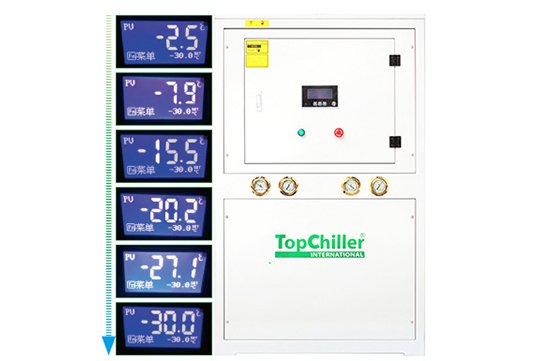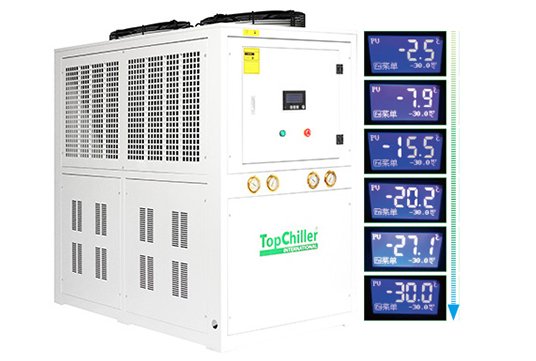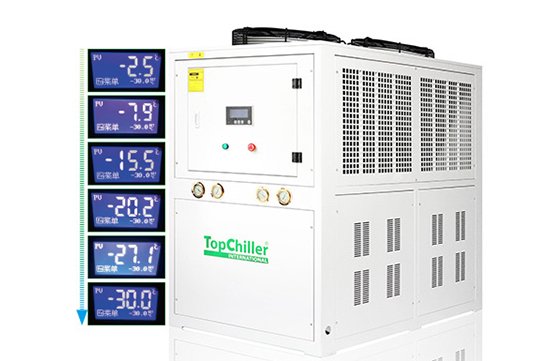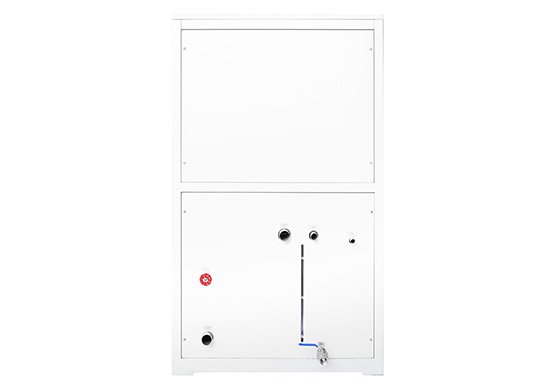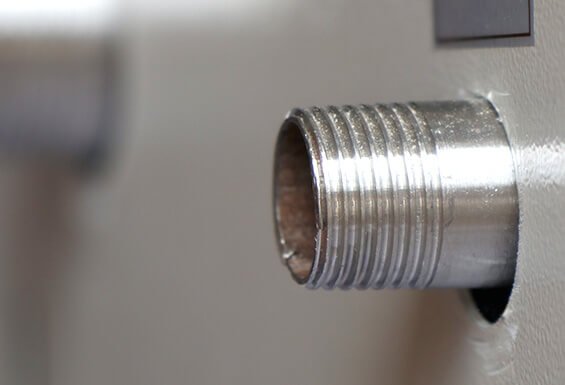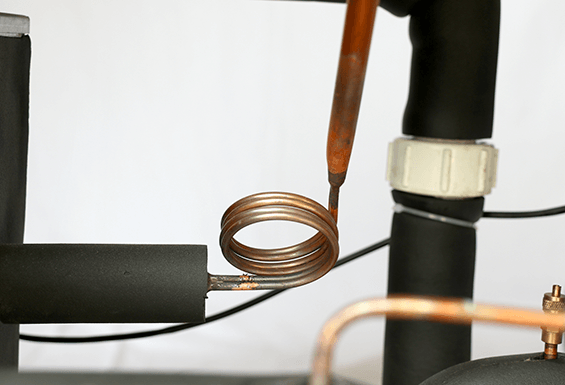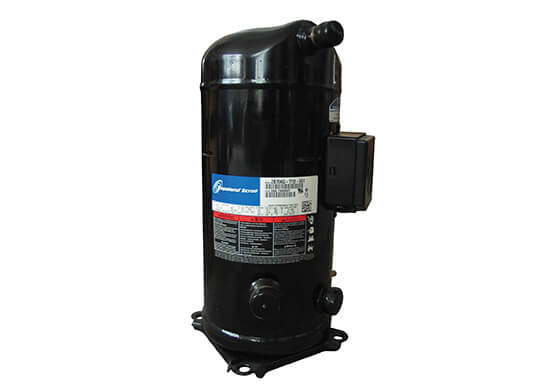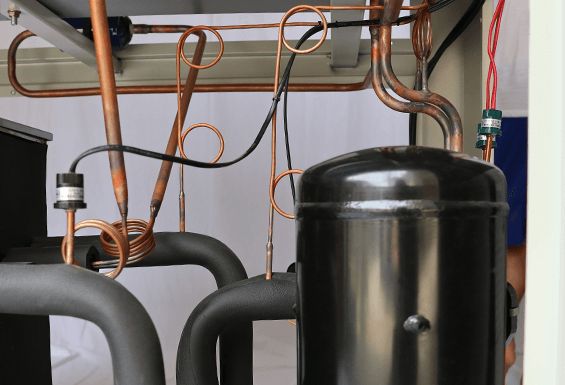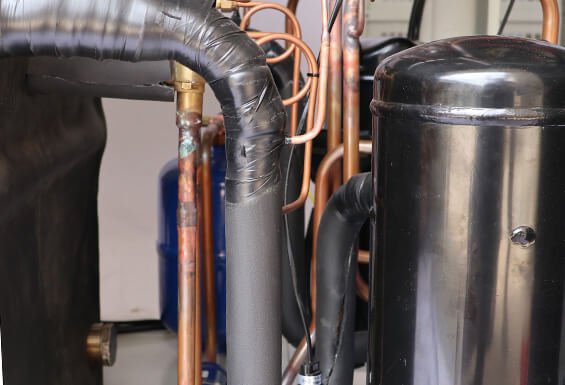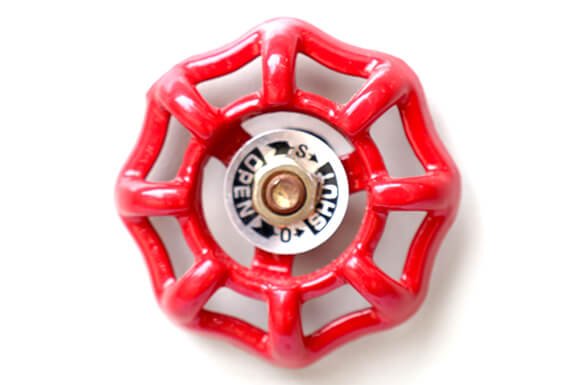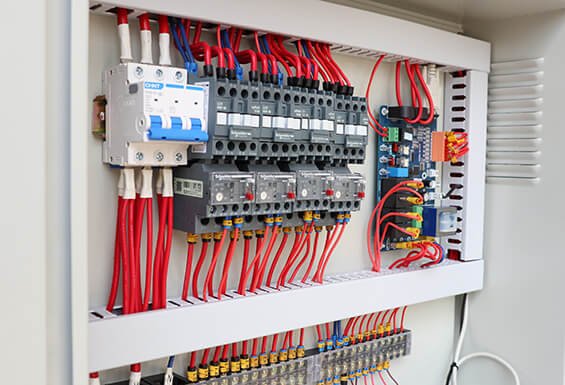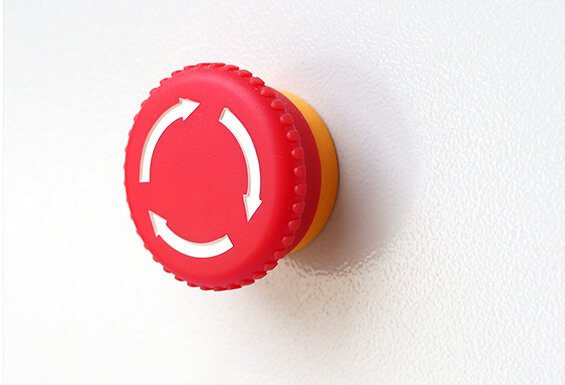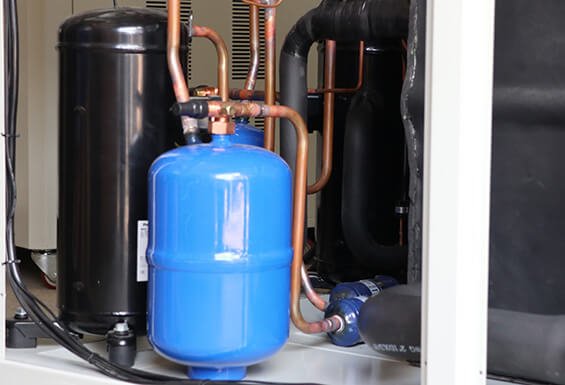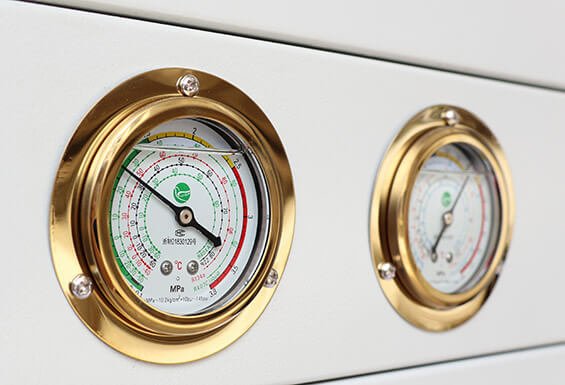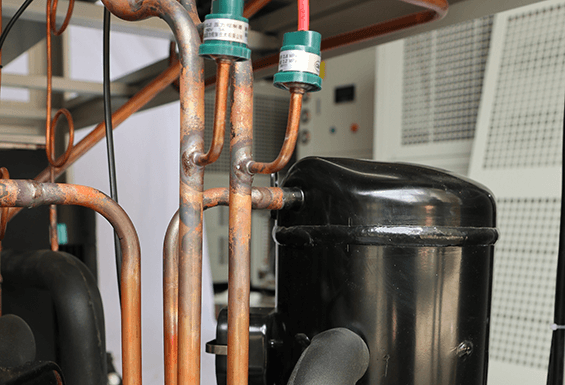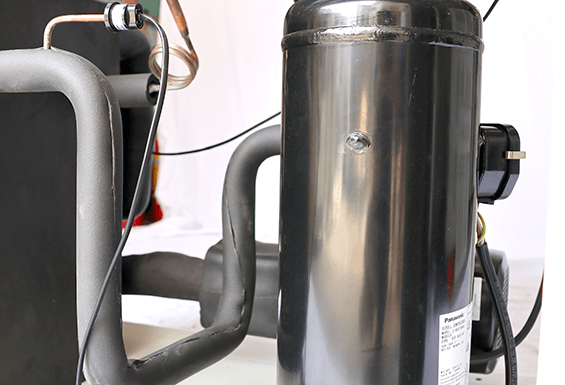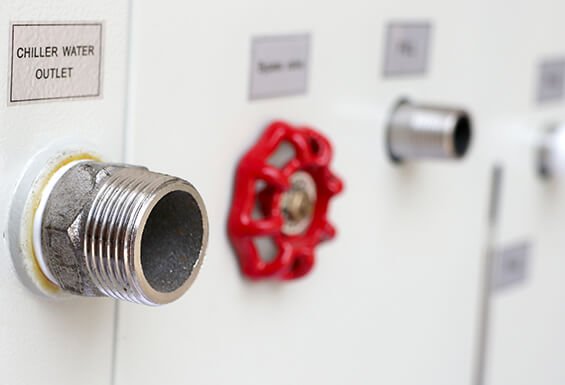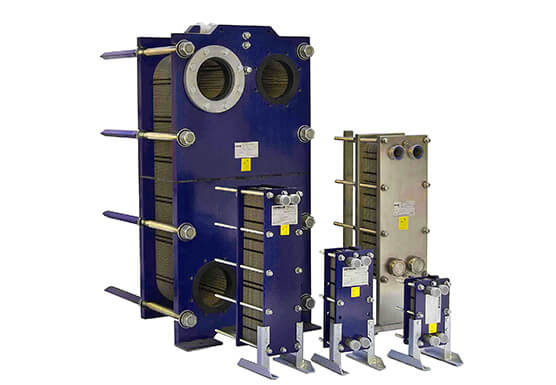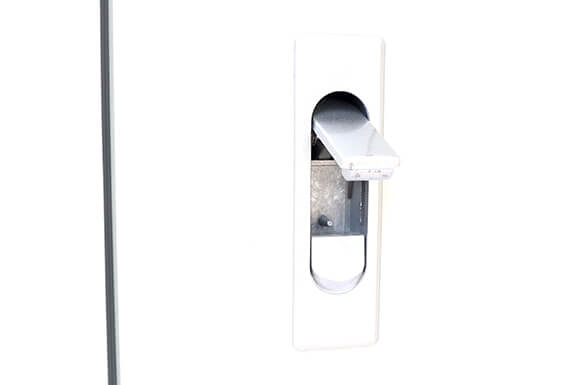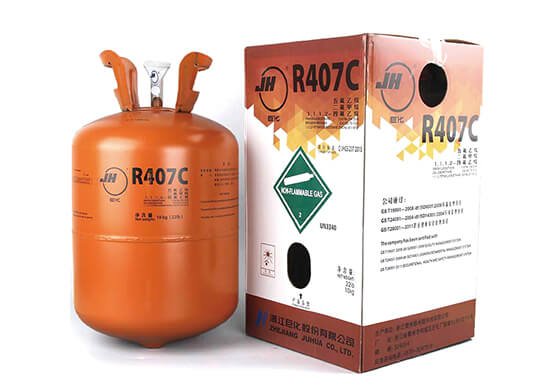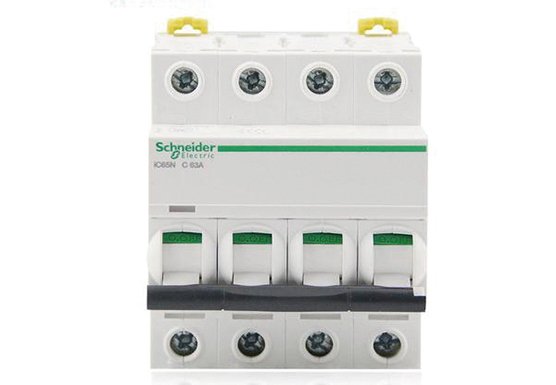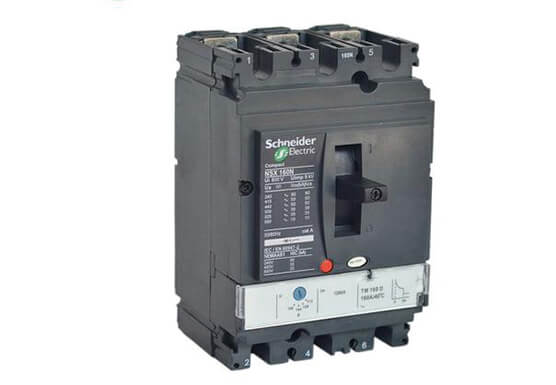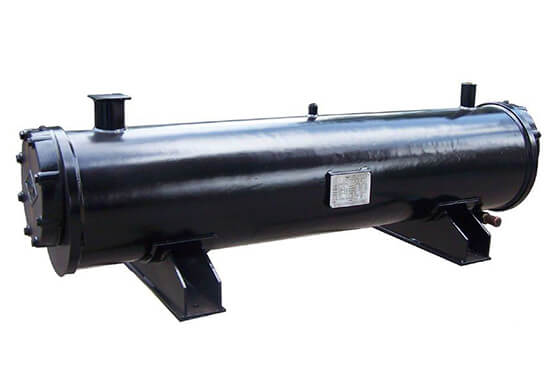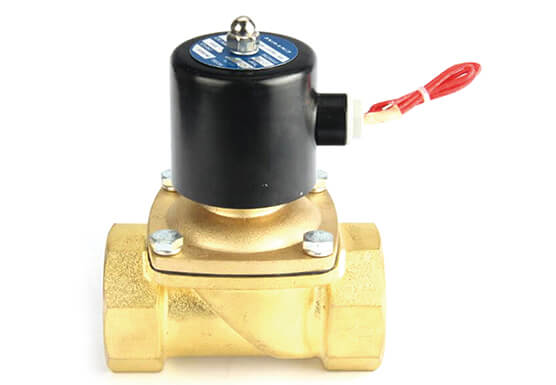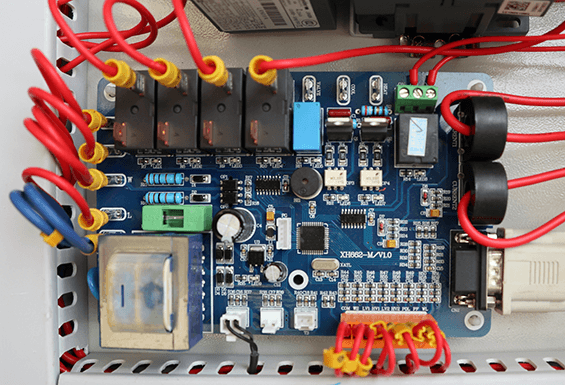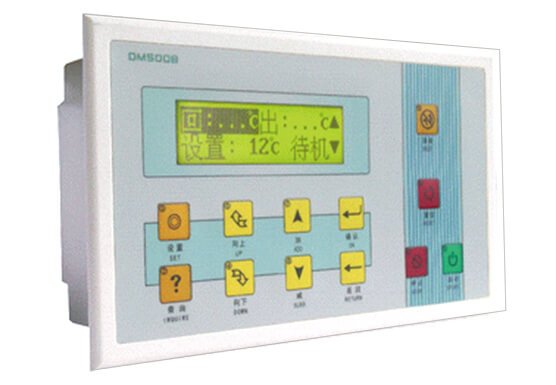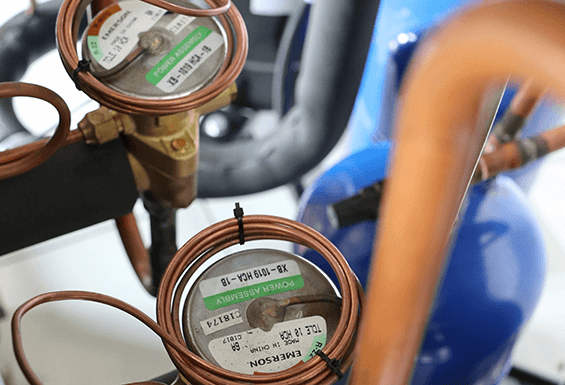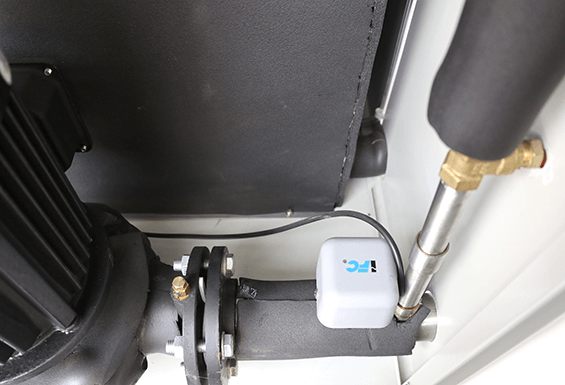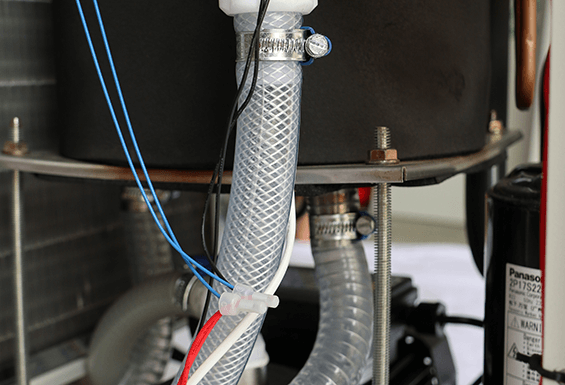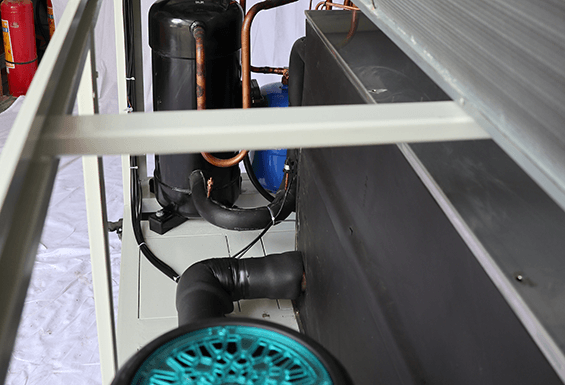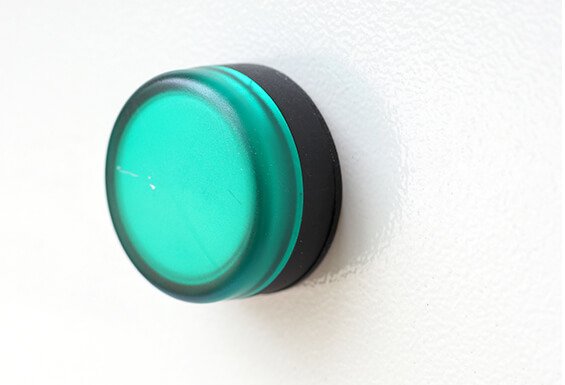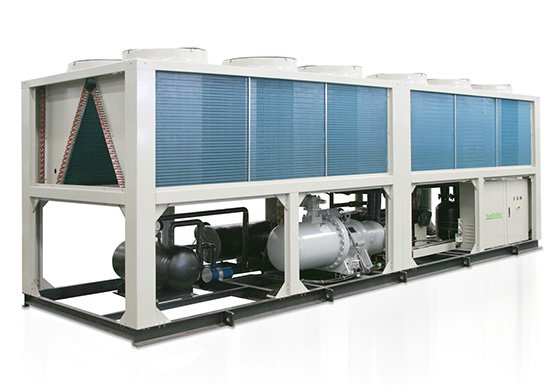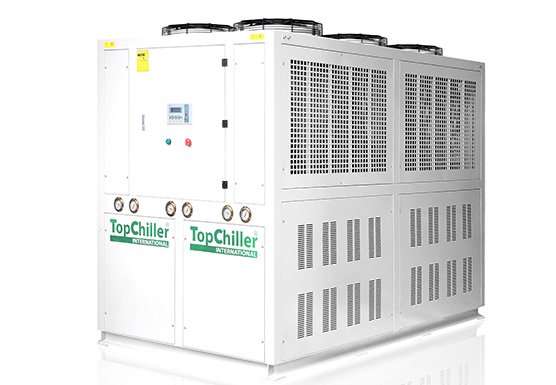TopChiller can design and manufacture all types of glycol chillers for you
- Hot gas bypass, pressure flow adjustment
- Stainless steel housing & aluminum base
- Touch screen display, crankcase heater
- Water pumps and stainless steel impellers
- Ethylene/propylene glycol installation
- Insulated heat exchanger & expansion valves
- Temperature control ranging -35℃ to +5℃
- Top-class highly efficient incline glycol filters
Your Premier Glycol Chiller Manufacturer and Supplier in China
Glycol Chiller is a refrigeration system-based cooling machine that is used for high cooling effect by the installation of glycol solution inside coils and heat discharge by air/water circulation around condensing unit.
TopChiller is the foremost company of China popular among international companies for its marvelous services, strong product portfolio, and world-class customer care all over the global world since 1999.
For over the last twenty years, TopChiller is offering a full line of Glycol Chiller models with different sizes by customizing innovative technologies in manufacturing and profoundly supplying to different industries meeting customer expectations.
TopChiller manufactured Glycol Chiller is composed of branded compressor, refrigerant, impeller, crankcase heater, Power unit, heat exchanger, impellers, water pump, glycol tank, suction, and expansion valve and power supply.
Glycol Chiller from TopChiller has a diverse number of benefits as given below:
- TopChiller designed Glycol Chiller is highly précised and optimal in its chilling operation featured by glycol installation inside glycol tank ensuring consistent heat discharge from the system with the assistance of glycol pumps that apply pressure on refrigerant for continuous flow.
- Anti-vibration systems are featured inside the Glycol Chiller at compressor discharge ensuring sound absorption for quiet operation and reducing pressure on fluid providing protection from pipe leakages.
- TopChiller designed Glycol Chiller is configured with crankcase heater that regulates the temperature of refrigerant entering in compressor and prevent the mixing of refrigerant with compressor oil.
- Glycol Chiller is constructed with energy-efficient compressors that ensure the steady and efficient flow of the refrigerant to produce an instant chilling effect with the support of pump and impellers applying pressure on fluid for fast heat exchange.
- Glycol Chiller has lower costs of maintenance featured by propylene /ethylene glycol that act as anti-refrigerant preventing coolant from freezing inside coils and shows resistance against corrosion configuring long service life with little requirements for maintenance.
TopChiller brand Glycol Chiller provides a high chilling effect and is used for different applications as:
Food and Beverage industry, refineries, wineries, fermentation industry, ice rinks, alcohol industry, pharmaceutical industry, paper, processed food cooling, ice–cream cooling.
If you are keenly interested to buy an energy-efficient and low-temperature cooling providing Glycol Chiller for your application?
If you are considering developing an association with a trustworthy company manufacturing precise Glycol Chiller for getting supportive guidelines to build up our business.
Make contact with TopChiller personnel and experts for getting any kind of information you need for making the best decision about the selection of a steadfast and reliable Glycol Chiller for your application at the best rates.
TopChiller professional employees are hands-on to provide the best customizing services and technical solutions to problems asked by clients.
General Description:
Glycol Chiller is a well-known and reliable glycol cooling unit that can decrease the freezing point for applications that works at a lower temperature.
Glycol Chiller designed by TopChiller is configured with a prime quality scroll compressor/screw compressor, shell or plate type heat exchangers, air/water-cooled condenser, impellers, expansion valves, glycol tank, and pumps.
Glycol Chillers manufactured by TopChiller have a wide range of low-temperature applications such as breweries, fermentation, distilleries, wineries, cider mills, and dairy milk processing.
The glycol is the primary constituent of Glycol Chiller that is used as a coolant to collect heat from system processing under its corrosion resistive and anti-freezing features.
TopChiller is a famous Glycol Chiller and Glycol Cooling System manufacturer and supplier based on their substantial innovations and refrigeration technology.
With its more than twenty years of leveraged experience, TopChiller has made its name over the global world by providing highly optimal and reliable Glycol Chiller to all its national and overseas customers.
If you search for an energy-efficient and low-temperature resistive Glycol Chiller for your applications, you will find TopChiller as the trustworthy manufacturer in China.
So contact us today via phone call to sort out your queries or place your order at the best suitable price. Our personnel and staff are directed to satisfy our clients at every step.
Features and Advantages:
The Glycol Chiller manufactured by TopChiller offers a diverse number of benefits under its credible design and reliability as given below:
- Energy-efficient and reliable performance with lower maintenance costs configured by installing impellers and EC fans inside the unit.
- Electrical control system and disconnect switches integration with Glycol Chiller alerts the personnel in an emergency by making alarms and circuit tripping.
- Insulated piping for glycol circulation ensures the chiller’s durability and long service life by preventing corrosion.
- Glycol installation as a coolant inside the chiller prevents the food from spoilage and increases the production rate in food processing under its low-temperature maintenance features.
- Lower freezing points of coolant assists Glycol Chiller to continue work even at the lower outside temperature configured by anti-freezing and high heat capacity properties of glycol.
TopChiller can manufacture customized Glycol Chiller according to your specific application requirements.
- Data Sheet
- Image Gallery
- Main Parts
- Video
Glycol Chiller Technical Specification
| Items/Model | Temp. | TPL-3AL | TPL-5AL | TPL-6AL | TPL-8AL | TPL-10AL | TPL-12AL | TPL-15AL | TPL-20AL | TPL-25AL | TPL-30AL | TPL-40AL | ||
| Cooling Capacity | KW 50HZ/60HZ | -10℃ | 3.80 4.60 | 6.30 7.60 | 7.50 9.00 | 9.10 10.90 | 13.20 15.80 | 16.10 19.30 | 19.50 23.40 | 26.40 31.70 | 32.20 38.60 | 39.00 46.80 | 52.00 62.40 | |
| -20℃ | 1.90 2.30 | 3.00 3.60 | 4.00 4.80 | 6.00 7.20 | 7.10 8.50 | 8.00 9.60 | 13.90 16.70 | 16.90 20.30 | 20.80 25.00 | 24.40 29.30 | 30.80 37.00 | |||
| -30℃ | 1.00 1.20 | 1.60 1.90 | 1.90 2.30 | 2.70 3.20 | 3.20 3.80 | 3.80 4.60 | 6.10 7.30 | 9.50 11.4 | 12.10 14.50 | 14.30 17.10 | 19.00 22.80 | |||
| -35℃ | 0.67 0.80 | 1.04 1.25 | 1.50 1.80 | 2.30 2.80 | 2.80 3.40 | 3.00 3.60 | 4.30 5.20 | 6.35 7.62 | 8.30 10.00 | 10.10 12.10 | 13.35 16.00 | |||
| Evaporator | Chilled Water (m³/h) | -10℃ | 0.65 0.79 | 1.10 1.30 | 1.30 1.50 | 1.60 1.90 | 2.30 2.70 | 2.80 3.30 | 3.40 4.10 | 4.50 5.40 | 5.60 6.70 | 6.70 8.10 | 9.00 10.80 | |
| -20℃ | 0.33 0.40 | 0.52 0.62 | 0.69 0.83 | 1.10 1.30 | 1.23 1.47 | 1.38 1.65 | 2.39 2.87 | 2.85 3.45 | 3.57 4.30 | 4.20 5.04 | 5.30 6.36 | |||
| -30℃ | 0.17 0.21 | 0.28 0.33 | 0.33 0.40 | 0.47 0.55 | 0.55 0.65 | 0.65 0.80 | 1.10 1.30 | 1.60 2.00 | 2.10 2.50 | 2.46 2.90 | 3.30 3.90 | |||
| -35℃ | 0.12 0.14 | 0.18 0.22 | 0.26 0.31 | 0.40 0.48 | 0.48 0.58 | 0.52 0.62 | 0.72 0.89 | 1.10 1.31 | 1.43 1.72 | 1.74 2.09 | 2.30 2.76 | |||
| Type | Shell and tube type/Plate type heat exchanger | |||||||||||||
| Inlet/outlet pipe | lnch | 1″ | 1″ | 1″ | 1″ | 1-1/2″ | 1-1/2″ | 2″ | 2″ | 2″ | 2-1/2″ | 2-1/2″ | ||
| Input power | KW | 3.18 | 4.86 | 5.61 | 7.25 | 9.4 | 10.9 | 13.5 | 18.8 | 22.55 | 28.5 | 37.5 | ||
| Max Current | A | 7.8 | 12 | 13.7 | 18 | 23 | 26.5 | 33 | 46 | 55 | 69 | 91 | ||
| Power Source | 3PH~380V/415V/480V~50HZ/60HZ(3PH~200V/220V 50HZ/60HZ) | |||||||||||||
| Refrigerant | Type | R22(R404A/R507) | ||||||||||||
| Control | z | |||||||||||||
| Compressor | Type | Hermetic scroll ( piston ) | ||||||||||||
| Power | KW | 2.25 | 3.75 | 4.5 | 6 | 7.5 | 9 | 11.3 | 7.5*2 | 9.37*2 | 11.3*2 | 30 | ||
| Condenser | Type | Efficient finned copper tube with aluminum + low noise external rotor fan | ||||||||||||
| Water pump | Power | KW | 0.75 | 0.75 | 0.75 | 0.75 | 1.1 | 1.1 | 1.5 | 2.2 | 2.2 | 4 | 5.5 | |
| Max lift | m | 20 | 20 | 20 | 20 | 20 | 20 | 20 | 20 | 20 | 25 | 20 | ||
| Safety protection | Compressor inner protection, over current protection, high / low pressure protection, over temperature protection, flow rate protection, phase sequence/phase missing protection, low level coolant protection, anti freezing protection | |||||||||||||
| Dimension | Length | mm | 980 | 1150 | 1150 | 1350 | 1500 | 1500 | 1860 | 2020 | 2020 | 2200 | 2350 | |
| Width | mm | 520 | 560 | 560 | 680 | 760 | 760 | 850 | 950 | 950 | 1150 | 1350 | ||
| Height | mm | 1170 | 1215 | 1215 | 1530 | 1660 | 1660 | 1900 | 2000 | 2000 | 1980 | 2000 | ||
| Net weight(KG) | Kg | 135 | 165 | 210 | 310 | 450 | 530 | 750 | 835 | 920 | 1080 | 1125 | ||
| Note: The above specifications are according to the following design conditions: 1, Chilled water inlet/outlet temperature difference 3℃/8℃. 2, Cooling air inlet/outlet temperature 30℃/38℃ | ||||||||||||||
Why TopChiller is Your Reliable Glycol Chiller Manufacturer and Supplier In China?
Glycol Chiller-An Ultimate FAQ Guide by TopChiller.
- What is Glycol Chiller?
- What are the Basic Components of a Glycol Chiller?
- What are the Key Features of a Glycol Chiller?
- What are the Applications of Glycol Chiller?
- Why is Glycol Preferred to Use for Glycol Chiller?
- What is the Working Principle of Glycol Chiller?
- What are the Advantages of Using a Glycol Chiller for your Applications?
- What is the Difference Between Glycol Chiller and Water Chiller?
- How Many Types of Glycol Chiller are Used for Breweries?
- How to Adjust Multiple Fermenter With your Glycol Chiller?
- Why Does a Glycol Chiller Used for Anti-Freezing Purpose?
- Which Types of Condensers are Integrated With Glycol Chiller?
- Which Types of Evaporators are Used for Glycol Chiller?
- How to Operate your Glycol Chiller for Startup Processing?
- How to Size a Glycol Chiller for your Application?
- What is the Installation Procedure for your Glycol Chiller?
- How to Troubleshoot your Glycol Chiller?
- What are the Maintenance Tips for your Glycol Chiller?
What is Glycol Chiller?
A Glycol Chiller is an energy-efficient industrial process unit that uses glycol to discharge heat from system processing.
Compressor, condenser, evaporator, and expansion valves connect to complete the refrigeration cycle of the chiller.
It is designed for food-grade applications and used for other industrial applications and is renowned for its easy Installation and lower temperature regulation.
Its maintenance is easy to do without substantial investment compared to the replacement requirements of other chillers.

Energy Saving Glycol Chiller Fabricated by TopChiller
What are the Basic Components of a Glycol Chiller?
The main components of Glycol Chiller that are involved in the refrigeration cycle and processing are given below:
Compressor
The compressor is the fundamental component of the refrigeration system of the Glycol Chiller. The scroll/screw compressor is taken depending on the type of application. The compressor is featured between condenser and evaporator.
The heated refrigerant at lower pressure enters the compressor. The compressor implements the compression force and increases the temperature and pressure of the refrigerant.
Evaporator
Evaporator or heat exchanger is shell and tube type heat exchanger and plate type heat exchanger.
The evaporator is configured for heat exchange. The processed heat collected from the system is being transferred to the refrigerant. The liquid phase also changes into the gaseous phase in the evaporator.
Condenser
Air-cooled condenser and water-cooled condenser are integrated with refrigeration cycle to cool down the refrigerant by heat dissipation towards the environment.
Expansion Valve/Throttling Element
Expansion valve or throttling element release the pressure of the refrigerant and converts the gaseous refrigerant into a liquid state for its recirculation in the evaporator.
Electrical Control System
The control system of the Glycol Chiller regulates its overall working. The pump and temperature, etc., are controlled and displayed on the screen by the control unit.
All essential components are connected with the control system through electrical cord guidelines.

Glycol Chiller Electrical Control System
What are the Key Features of a Glycol Chiller?
A Glycol Chiller is configured to use for a wide variety of applications requiring cooling effect under its fundamental features as given below:
- Ethylene glycol or propylene glycol installation for cooling at a lower temperature
- R134A refrigerant/R404A refrigerant is installed for the refrigeration system
- Glycol Chiller is available with cooling capacity range ½ Ton to 100 Ton
- The energy-efficient and reliable cooling device
- Easy Installation and feasible operating
- Easy maintenance and energy saving
- Working without any problem of solidification
- Glycol temperature controlling unit
- Integration of power connections with three pins for fermenter
- Capability to cool the fermenter at temperature ranges 4˚C to 6˚C
- Display screens and control unit
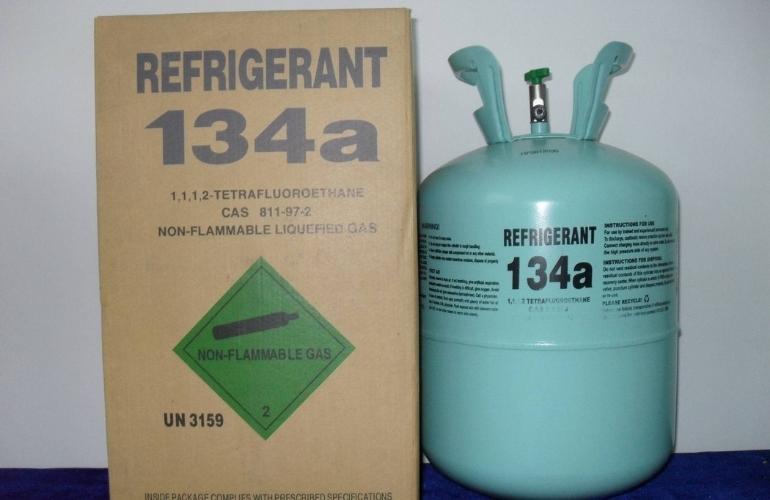
R134A Refrigerant for Glycol Chiller
What are the Applications of Glycol Chiller?
A Glycol Chiller is a specified cooling unit that uses glycol and water mixture with a different ratio as a coolant for heat transfer.
It is renowned for consistent maintenance of lower temperature for an assorted number of applications as given below:
- Food Processing
- Chemical Industries
- Dairy Milk Processing
- Breweries
- Ice Rink
- Cider Mills
- Fermentation
- Wineries
- Distilleries
- Commercial Applications

Glycol Chiller Applications
Why is Glycol Preferred to Use for Glycol Chiller?
Glycol is used as a coolant to exchange heat and cooling purposes of applications. It is a water-miscible coolant. The glycol is preferred to install in Glycol Chiller as:
- It has a low melting point than water, with the capability to stay in a liquid state even for the lower temperature of the outer environment.
- Two types of glycol are available as ethylene glycol and propylene glycol. Its Installation depends on the type of application.
- For food processing applications, propylene glycol is used. While for industrial purposes, ethylene glycol is being used.
- Glycol can cool the applications at a temperature lower than the freezing point of water.
- The heat absorption capacity of glycol is much more significant to assist the cooling of applications.
- Glycol also has resistance against corrosion and acts as an anti-freezing agent for various applications requiring chilled temperature.
- It also discourages microbial growth in food processing as fungal growth inhibition.
What is the Working Principle of Glycol Chiller?
A Glycol Chiller is a cooling unit configured to dissipate system heat using glycol coolant.
The basic working principle is the compression and evaporation process over the refrigerant. The operational steps of the Glycol Chiller are given below:
Step 1
The glycol mixture is filled within the glycol tank. After turning on the unit, glycol coolant circulates in tubing towards the industrial applications or food processing plant.
The glycol coolant absorbs heat from the system, ensuring lower temperature for the food processing and getting heated.
The warmth coolant then enters the refrigeration circuit to transfer heat and recover its cooling.
Step 2
The warm coolant enters in evaporator/heat exchanger. The tubing system of the heat exchanger contains refrigerant flooding inside tubes.
While the coolant flows around the refrigerant in the counter-current manner for heat transfer.
The refrigerant absorbs heat from the coolant and changes its phase from liquid to gaseous state. The refrigerant under lower pressure then moves towards the compressor.
Step 3
The scroll/screw type compressor is the fundamental component of the refrigeration cycle in Glycol Chiller. The refrigerant with the gaseous phase enters the compressor.
The compressor implies compression force to increase the temperature and the pressure of the refrigerant. Then refrigerant rushes towards the condenser.
Step 4
The condenser mediates the final discharge of heat from the refrigerant. The heat from the refrigerant is being absorbed either by the air or water circulating over the refrigerant.
The air dissipates out from the condenser. But in the case of water, the hotter water from the condenser moves towards the water tank to get cool.
Step 5
After heat discharge, the pressure is released from the refrigerant through an expansion valve, and the gaseous refrigerant condenses back into the liquid state.
Step 6
The liquid refrigerant again enters the evaporator to repeat the cycle for system heat dissipation coming along coolant.
What are the Advantages of Using a Glycol Chiller for your Applications?
A Glycol Chiller is a renowned industrial processing unit that configures the cooling of different industrial applications with a wide range of benefits as given below:
Protection of Food Spoilage
It ensures a consistent cooling supply to protect the frozen foods from rotten or spoilage.
Food Quality
The processed food under chilled temperature comes with the best taste and quality.
Anti-Freezing Property
The glycol coolant has lower melting points that prevent it from freezing at its target site with the assurance of reliable performance. Temperature is maintained even at a narrowing range as -1˚C or +1˚C.
Lower Costs
The rugged design of the Glycol Chiller assists its easy maintenance with lower costs and environment-friendly behavior.
Energy Efficient Performance
Expansion valves, economizer, and condenser fans collectively help the Glycol Chiller give an energy-efficient performance.
What is the Difference Between Glycol Chiller and Water Chiller?
Glycol Chiller
- Glycol Chiller is a unique cooling device designed for food-grade applications requiring lower temperatures.
- It is installed in an application for heat discharging with ultimate production of cooling effect.
- It contains glycol as a coolant that circulates in the system for heat absorption.
- The freezing point is lower than water and retains protected from freezing even at low ambient temperature.
- Its heat absorption capacity is also greater just because of glycol mixture installation.
Water Chiller
- A water chiller is also a cooling unit that cools different industrial applications.
- It is configured with a refrigeration system that ultimately releases heat from the system.
- The freezing point of water is less than glycol so that it can be frozen quickly compared to glycol for applications dealing with freezing temperatures.
- Water is used as a coolant for the water chiller instead of glycol.
- The heat-absorbing capacity is also less than Glycol Chiller.
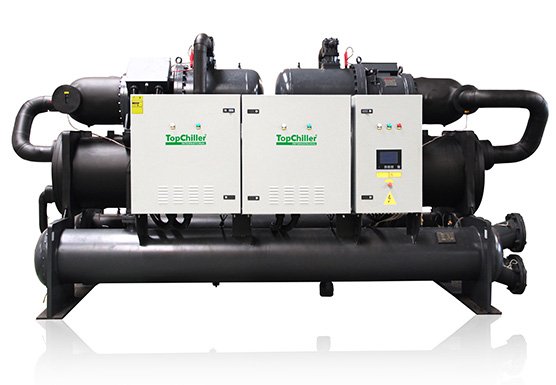
Water Chiller
How Many Types of Glycol Chiller are Used for Breweries?
There are three different types of Glycol Chiller for breweries, as given below:
Packaged Glycol Chiller
It is designed for breweries as a self-contained unit, having all of its essential components for chilling are integrated with one unit.
This packaged unit also has a pump and tank involved in the chilling process of breweries.
Glycol is installed as a coolant in it for breweries. It can easily be installed outdoors if there is lower space for indoor Installation.
Modular Glycol Chiller
It is considered a reliable and renowned unit for breweries as it can be integrated into the running system.
The Modular Glycol Chiller can be attached to the already working chiller for running a larger brew.
The modulating system assists breweries in renting the chiller modules as per requisite instead of purchasing, resulting in the saving of substantial investment.
But one drawback is that it has less working efficiency than the single Glycol Chiller.
Split Glycol Chiller
It is preferred to use as ideal for breweries because it works efficiently to maintain the temperature suitable for fermentation.
The heat exchangers are placed outdoors while all other components are indoors to compensate for the issue of lower space.
How to Adjust Multiple Fermenter With your Glycol Chiller?
- A Glycol Chiller is widely used in food processing, and several industrial applications as a glycol can maintain the fermenter’s temperature at 4˚C to 6˚
- It consists of a pump with which the fermenter is connected. The pump has four options to connect multiple fermenters with it.
- The four fermenters of 30 liters can efficiently be cooled down by one Glycol Chiller at a time instead of installing more than one chiller
- For connecting additional fermenters, firstly ensure the topping up of glycol tank
- After that, connect the additional units with it by adding almost 600ml glycol solution for each other unit so that glycol may run around the fermenter.
- After that, connect the fermenters with Glycol Chiller in the proper position. Make sure that the connecting point should be exact on the chiller
- Label the fermenter and chiller connections with the same numbering before plugging to reduce the error.
- If glycol level falls from the setpoint and fermenter gets dried, the pump turns off automatically under beeping noise production. In this situation, the tank is refilled with glycol to continue the process.
Why Does a Glycol Chiller Used for Anti-Freezing Purpose?
The Glycol Chiller is used for anti-freezing purposes due to its some unique characteristics as given below:
- Its glycol coolant has a lower freezing point and more excellent stability than water coolant. These characteristics of glycol prevent it from freezing at a temperature below freezing point.
- To get rid of the freezing in chilling processes, glycol is mixed with water in specified proportions, resulting in a decrease in the freezing temperature of the coolant, and no freezing will occur.
- For this reason, the Glycol Chiller is used as an anti-freezing agent under glycol installation.
- Glycol is also famous for its more excellent heat conduction capability. Therefore it assists the chiller to provide a consistent supply of lower temperatures for different applications.
Which Types of Condensers are Integrated With Glycol Chiller?
A Glycol Chiller is integrated with two types of condenser for heat dissipation from the refrigerant as given below:
Air Cooled Condenser
The air-cooled condenser discharges heat from the gaseous refrigerant by absorbing through air circulation around the refrigerant circulation.
After heat transfer, the air is released into the environment. At the same time, the refrigerant condenses back into a liquid state and returns to the evaporator.
Water Cooled Condenser
The water-cooled condenser used for Glycol Chiller contains chilled water circulation from the water tank to absorb heat from the refrigerant.
The refrigerant when enters the water-cooled condenser; heat is exchanged from refrigerant to water tubing over refrigerant circulation.
The heated water moves back towards the chilled water tank to cool back.
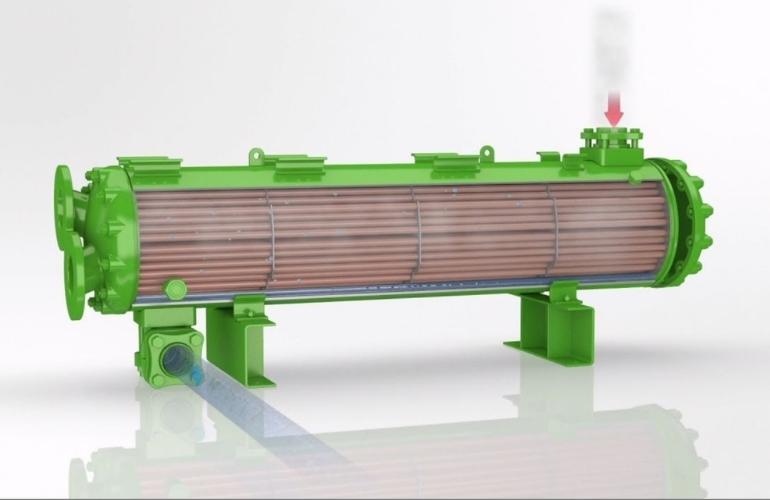
Glycol Chiller Water Cooled Condenser
Which Types of Evaporators are Used for Glycol Chiller?
Two types of evaporator/heat exchangers are used for Glycol Chiller for heat transferring between refrigerant and fluid coming from a system that is:
Shell and Tube Type Evaporator
The shell and tube type evaporator consists of a shell containing a bundle of tubules in which the refrigerant circulates. Convoluted tubes come in contact with another fluid circulating over tubes.
The heat is exchanged between these two fluids. The arrangement of tubes inside the shell can vary as U-shaped, floating head tubes, etc.
Plate Type Evaporator
The plate-type evaporator consists of copper/aluminum corrosion resistive coils inserted inside the plate to make the heat exchanger smooth and flat-surfaced.
The plate-type evaporator is easy to clean and maintain. It also assists in the heat exchange for applications preserved at freezing temperatures.
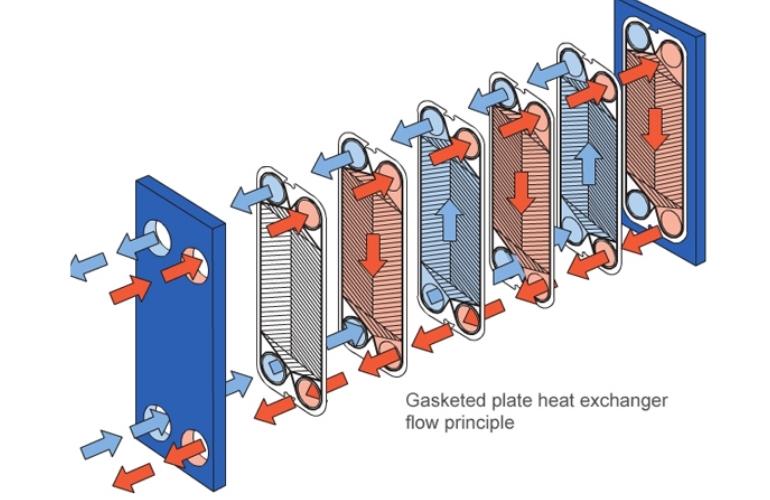
Glycol Chiller Plate Type Evaporator
How to Operate your Glycol Chiller for Startup Processing?
To start up cooling processing by Glycol Chiller, there is a need to follow a checklist to operate the unit as given below:
Step 1
Connect the power supply to the chiller and check all electrical codes connected with each component. A safety switch or disconnect switch should also be integrated besides the unit.
Step 2
Make sure that all electrical connections should be tight to its electric cord. To inspect this, open the electrical panel and check all connections.
Any loose connection can cause damage to the motor as connections may get loosened during shipping.
Step 3
Take out the chiller’s service panels, rotate counterclockwise the handle, and open the glycol valve.
Step 4
Fill the tank with water if it is installed with pro-chiller Installation. Otherwise, locate the tank at its specific site and fill it with water (not glycol yet).
Step 5
After that, adjust the switching of all circuits of Glycol Chiller at the ‘On’ position. After turning on, the switch pump will start the circulation of water. Also, open the heat exchangers for flushing with water.
Step 6
Ensure the water flow rate from the pump and its direction of rotation. If you find any disturbance within the system, amend it accordingly.
Step 7
Turn off the Glycol Chiller after 15 to 30 minutes of flushing processing and drain the water. After water dissipation, fill the tank with glycol.
Step 8
After that, by inspecting evaporators and condensers, turn on the chiller. The pump will start working while the compressor will be configured to turn on/off for specified glycol level maintenance.
How to Size a Glycol Chiller for your Application?
The entire stock of Glycol Chiller is available in the market. You can size it for your application by keeping in view some considerations as:
Cooling Capacity
The chillers are designed with different cooling capacities. First, calculate the cooling requirements of your application and select the Glycol Chiller accordingly.
Condenser Type
Air cooled chillers occupy less space and are easy to maintain if you have little space for Installation, select it.
The water cooled chillers have an additional water tank and occupy space but ensure the best efficiency. Select the suitable water supply and space for your application if you have the best water supply and space.
Water Flow
The pumps are necessary for Glycol Chiller that is available with different flow rates. Select the chiller as per your flow rate requisites.
What is the Installation Procedure for your Glycol Chiller?
At the working site, the Glycol Chiller can be installed by following steps as given below:
Inspection
After receiving the chiller, make sure to remove the packaging material carefully. Carefully examine all components to find any damage before the unit installation.
Site of Installation
- Select the site with the free area at the front and sides of the Glycol Chiller for its flawless work.
- Prefer to install it at the place near the processing unit/application.
- The installation surface should be feasible for a clear screen view and emergency alarms.
- The surface should be leveled, and the condenser must be almost 48 inches away from obstructions.
Piping
- Install all of the piping of Glycol Chiller as per ASHRAE compliance piping guidelines.
- Water piping is installed for the water-cooled condenser.
- Leaks and damages of pipes are inspected before glycol installation in the tank.
- The piping system is insulated for lower temperature and glycol passage.
- After piping installation, circulate water from the piping to identify the leakage points before glycol installation.
Wiring
- The Glycol Chiller is then integrated with an electric supply for handling load.
- Disconnect switches are also connected with the power supply. If not factory-installed, then integrate disconnect switches with chiller. Also, ensure that the motor must rotate in a clockwise direction.
Evacuation
- Refrigeration pipes are installed. After that, the chiller is mediated for evacuation.
- Vacuum pumps are used for 350 microns evacuation of Glycol Chiller.
- All contaminants and humidity is being evacuated to ensure the protection of the compressor from corrosion.
Charging of the System
- After evacuation, the chiller is being charged by the refrigerant.
- Liquid line fittings are connected with the charge line so that the refrigerant with liquid phase flows inside the system until the pressure of the system does not match the cylinder.
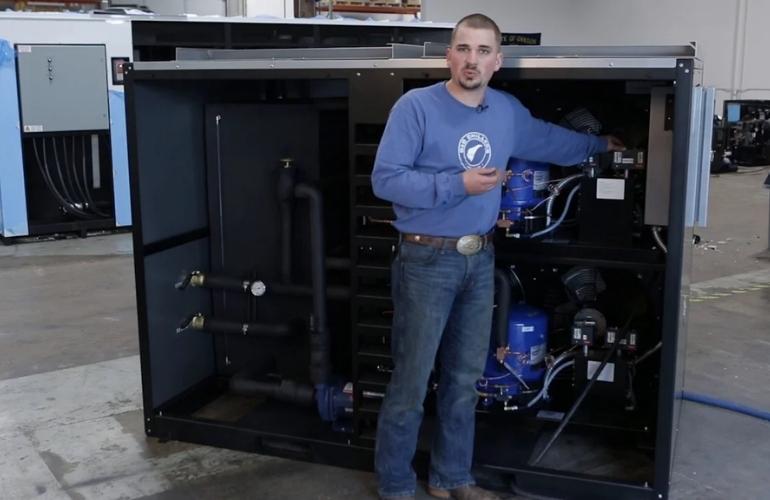
Glycol Chiller Installation
How to Troubleshoot your Glycol Chiller?
Sometimes the Glycol Chiller stops its working or lowers its working efficiency due to any obstruction or problem within the chiller.
The problems faced by the chiller can be troubleshot in the following way:
Compressor not Running
- If the compressor is not running, different drawbacks may occur in operation as the pump will stop running, the solenoid valve will not open, thermal overloading, etc.
- Call the technician, inspect all wires and their junction, and tighten them to sort out the problem. Check out the solenoid and replace the coils with the new one. Set the voltage level and examine the motor to troubleshoot the problem.
Vibrations in Compressor
- Sometimes compressors produce sounds and make vibrations while working that may cause by a high amount of refrigerant entering the compressor.
- To troubleshoot the problem, replace the compressor with the new one, maintain the proper glycol level or set the superheating point of an expansion valve.
Decreased Discharge Pressure
- Low refrigerant charge and low ambient conditions may cause a decrease in discharge pressure.
- Inspect any leakage or damage, regulate the water valves, and monitor the fans’ control unit for troubleshooting the problem.
Tripped Circuit Breaker
- Low voltage or imbalance in voltage level, loose wiring of Glycol Chiller may cause tripping of a circuit breaker.
- The problem can be solved by maintaining voltage, replacing the leaked wires with a new one, and integrating the ventilation system with the motor.
What are the Maintenance Tips for your Glycol Chiller?
Some maintenance tips should be followed while dealing with your Glycol Chiller as:
Glycol Bath
Ensure that the glycol bath is covered with a lid to prevent the glycol mixture from adding water vapours so that the glycol solution does not get diluted.
Motor
The motor should be inspected almost after one month to deal with motor overheating and obstruction in the smooth surfacing.
Pumps
The pipe monitoring should be done every month to inspect any leakage. If there is any leakage in piping, replace it with now one or adjust them for normal working.
Also, check out the points with missing insulation and manage these points.
Condenser
To clean and maintain the condenser, remove its grills so that the condenser fins may come at exposure directly.
Then clean it by using a vacuum. Compressor gas and bristled brush are also utilized for fins cleaning purposes. Also, filter out the airflow passage by dissipating dust and debris from the air.
Glycol Mixture
The viscosity and quality of the glycol mixture should be inspected after six months.
A refractometer should be used for an inspection right after eighteen months to validate the glycol mixture viscosity per requirements.
Usually, the glycol percentage is kept at 20% to 25%.
